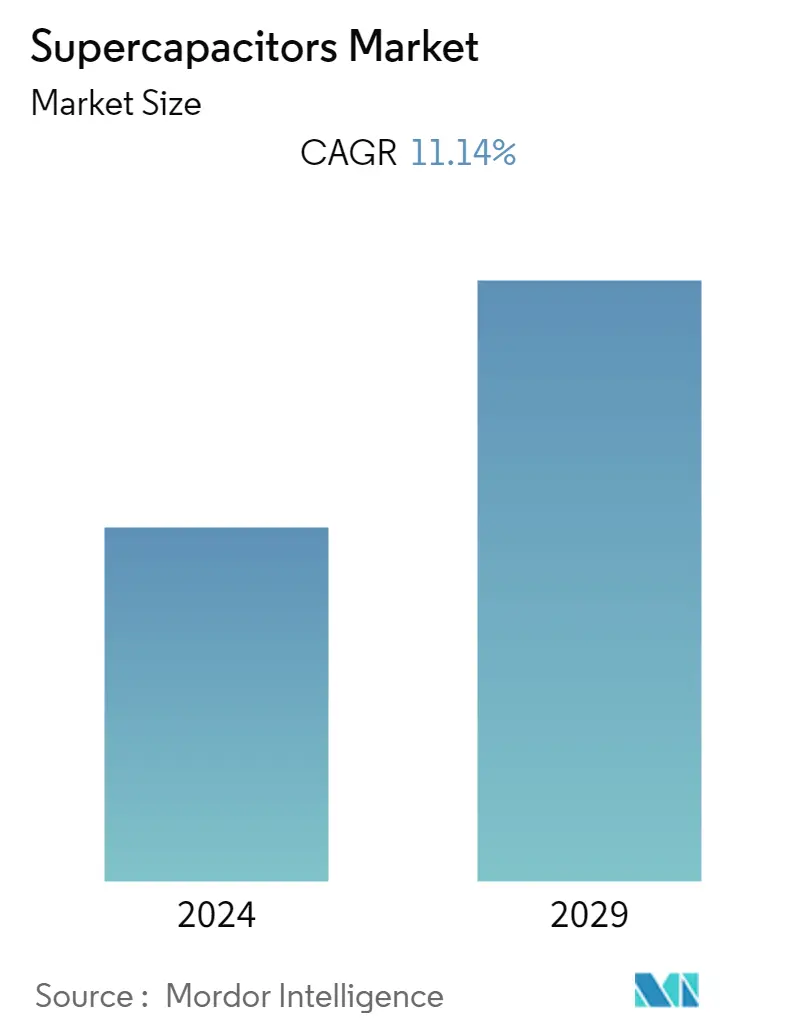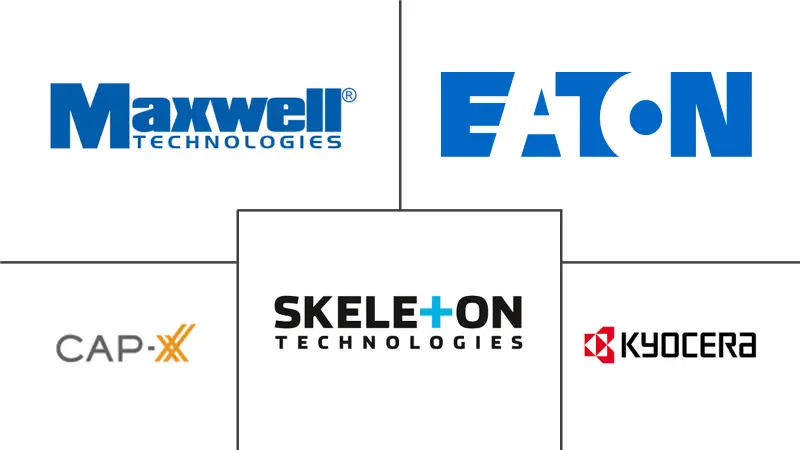Market Size of Supercapacitors Industry

| Study Period | 2019 - 2029 |
| Base Year For Estimation | 2023 |
| CAGR | 11.14 % |
| Fastest Growing Market | Asia-Pacific |
| Largest Market | Europe |
| Market Concentration | Low |
Major Players
*Disclaimer: Major Players sorted in no particular order |
Supercapacitors Market Analysis
The Supercapacitors Market size is estimated at USD 0.69 billion in 2023, and is expected to reach USD 1.17 billion by 2028, growing at a CAGR of 11.14% during the forecast period (2023-2028).
Supercapacitors are replacing traditional electric car batteries with quick charging and temperature stability. Additionally, supercapacitors are more flexible than standard batteries. The high demand for a stable power supply for applications such as GPS, portable media players, laptops, and mobile devices, is an emerging trend in the market studied.
- Supercapacitor charging and discharging also helps sustain peak loads and backup power, which is significant for continuous operation. It includes battery-powered industrial applications such as smart meters, smoke detectors, video doorbells, and medical applications. To support this, various vendors are launching new products. For instance, Texas Instruments (TI) recently announced a new bidirectional buck/boost converter with a quiescent current (IQ) of 60 nA. Additionally, compared to frequently used hybrid-layer capacitors, the TPS61094 buck/boost converter includes a buck mode for supercapacitor charging while delivering ultra-low IQ, allowing engineers to extend battery life by up to 20%. (hybrid-layer capacitors (HLCs)).
- Further research is underway in developing affordable and innovative solutions built on existing supercapacitor technology. It offers a more affordable and ecological alternative to present models and emphasizes the need to reduce the carbon-based electrode production cost and the dependency on crucial components. For instance, researchers from Imperial College London and University College London (UCL) recently developed a more sustainable and energy-dense electrode material for supercapacitors, paving the way for further market use of high-power, quick-charging electric vehicle technology.
- In recent years, communication systems in telecom and space have propelled the supercapacitors demand. The Indian Space Research Organization (ISRO), at its Vikram Sarabhai Space Center (VSSC), developed the technology for processing supercapacitors (2.5 V) of varying capacitance values viz., 5 F, 120 F, 350 F, and 500 F, catering to specific applications related to space and societal needs. Supercapacitors are effectively being used to improve the efficiency of hybrid electric vehicles in various ways.
- For instance, Maxwell developed a supercapacitor-connected lead-acid battery that may be used to replace a traditional vehicle battery. The idea behind this application is that high-energy demands, such as starting an automobile, reduce the battery's total energy capacity. The company has a line of supercapacitor-based modules that can reach temperatures of 3000 degrees Fahrenheit. Over 600,000 supercapacitors have been sold for hybrid start-stop applications.
- Furthermore, various market vendors have witnessed increased sales in the electric vehicle business, pushing the supercapacitor growth in the automotive industry. For instance, according to EV volumes, for the entire year of 2022, sales of 10,6 million were expected, showing a growth of 57 % over 2021, with BEVs reaching 8 million units and PHEVs 2,6 million units. Also, by the end of 2022, it was expected that there would be nearly 27 million EVs in operation, counting light vehicles, 70 % BEVs, and 30 % PHEVs.
- Additionally, with the COVID-19 outbreak, the power sector is impacted by the economy's digital revolution. From smart meters, digital substations, and smart EV charging infrastructure to software solutions, such as artificial intelligence, digital twins, dynamic line rating, and blockchain technology, governments, utilities, and manufacturers, are increasingly embracing digital technologies. For instance, after successfully advancing smart grid deployment and mobilizing investments of USD 300 million through its National Smart Grid Mission, the Indian government recently announced a Revamped Distribution Sector Scheme with a cost of over USD 40 billion and gross budgetary support of over USD 10 billion. Such investments are expected to bring new opportunities to the supercapacitor market.
Supercapacitors Industry Segmentation
Supercapacitors (or ultracapacitors) utilize high surface area electrode materials and thin electrolytic dielectrics to achieve high capacitance values. They have more capacitance than conventional capacitors and store more energy. Supercapacitors can be of various types, such as double-layer, pseudo, and hybrid capacitors. They can be used for different end-user industries, such as consumer electronics, energy and utilities, industrial, and automotive.
The Supercapacitors Market is segmented by end-user (consumer electronics, energy, and utilities (grid applications, wind, and others), industrial (automotive/transportation (bus and truck, rail and tram, 48 V mild hybrid car, micro hybrids, and other cars, heavy vehicle), and geography (United States, Europe, China, Japan, Korea and rest of Asia, and rest of the world). The market sizes and forecasts are provided in value (USD) for all the above segments.
| By End-User | |||||||
| Consumer Electronics | |||||||
| |||||||
| Industrial | |||||||
|
| By Geography | |
| United States | |
| Europe | |
| China | |
| Japan | |
| Korea and Rest of Asia | |
| Rest of the World |
Supercapacitors Market Size Summary
The supercapacitors market is experiencing significant growth, driven by their increasing adoption in various applications such as electric vehicles, portable electronics, and industrial devices. Supercapacitors are gaining popularity due to their advantages over traditional batteries, including rapid charging capabilities, temperature stability, and flexibility. The demand for stable power supply solutions in devices like GPS, laptops, and mobile phones is a key trend propelling market expansion. Additionally, supercapacitors are being integrated into smart meters, smoke detectors, and medical devices, enhancing their functionality and reliability. The market is also witnessing innovation, with companies like Texas Instruments introducing advanced components to optimize supercapacitor performance and extend battery life.
The global push towards electric vehicles and renewable energy solutions is further boosting the supercapacitors market. In regions like China and Japan, government policies and initiatives are fostering the development and adoption of electric vehicles, which in turn increases the demand for supercapacitors. Prominent players in the market, such as Eaton Corporation and Maxwell Technologies, are leveraging strategic partnerships and technological advancements to enhance their product offerings and expand their market presence. The market is moderately competitive, with established companies focusing on innovation and collaboration to maintain their leading positions. As digital technologies and smart grid solutions gain traction, the supercapacitors market is poised for continued growth, offering new opportunities for manufacturers and stakeholders.
Supercapacitors Market Size - Table of Contents
-
1. MARKET INSIGHTS
-
1.1 Market Overview
-
1.2 Industry Attractiveness - Porter's Five Forces Analysis
-
1.2.1 Bargaining Power of Suppliers
-
1.2.2 Bargaining Power of Consumers
-
1.2.3 Threat of New Entrants
-
1.2.4 Threat of Substitute Products
-
1.2.5 Intensity of Competitive Rivalry
-
-
1.3 Assessment of the Impact of COVID-19 on the Market
-
-
2. MARKET SEGMENTATION
-
2.1 By End-User
-
2.1.1 Consumer Electronics
-
2.1.2 Energy and Utilities
-
2.1.2.1 Grid Applications (Including Micro Grid and UPS)
-
2.1.2.2 Wind and Others
-
-
2.1.3 Industrial
-
2.1.4 Automotive/Transportation
-
2.1.4.1 Bus and Truck
-
2.1.4.2 Rail and Tram
-
2.1.4.3 48V Mild Hybrid Car
-
2.1.4.4 Micro Hybrids and Other Cars
-
2.1.4.5 Heavy Vehicles
-
-
-
2.2 By Geography
-
2.2.1 United States
-
2.2.2 Europe
-
2.2.3 China
-
2.2.4 Japan
-
2.2.5 Korea and Rest of Asia
-
2.2.6 Rest of the World
-
-
Supercapacitors Market Size FAQs
What is the current Supercapacitors Market size?
The Supercapacitors Market is projected to register a CAGR of 11.14% during the forecast period (2024-2029)
Who are the key players in Supercapacitors Market?
Eaton Corporation PLC, Skeleton Technologies Inc., Cap-XX Limited, Maxwell Technologies Inc. (Tesla Inc.) and Kyocera Corporation are the major companies operating in the Supercapacitors Market.

